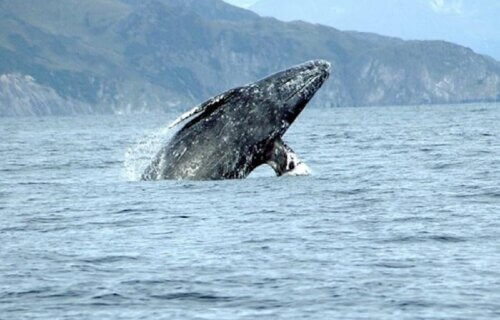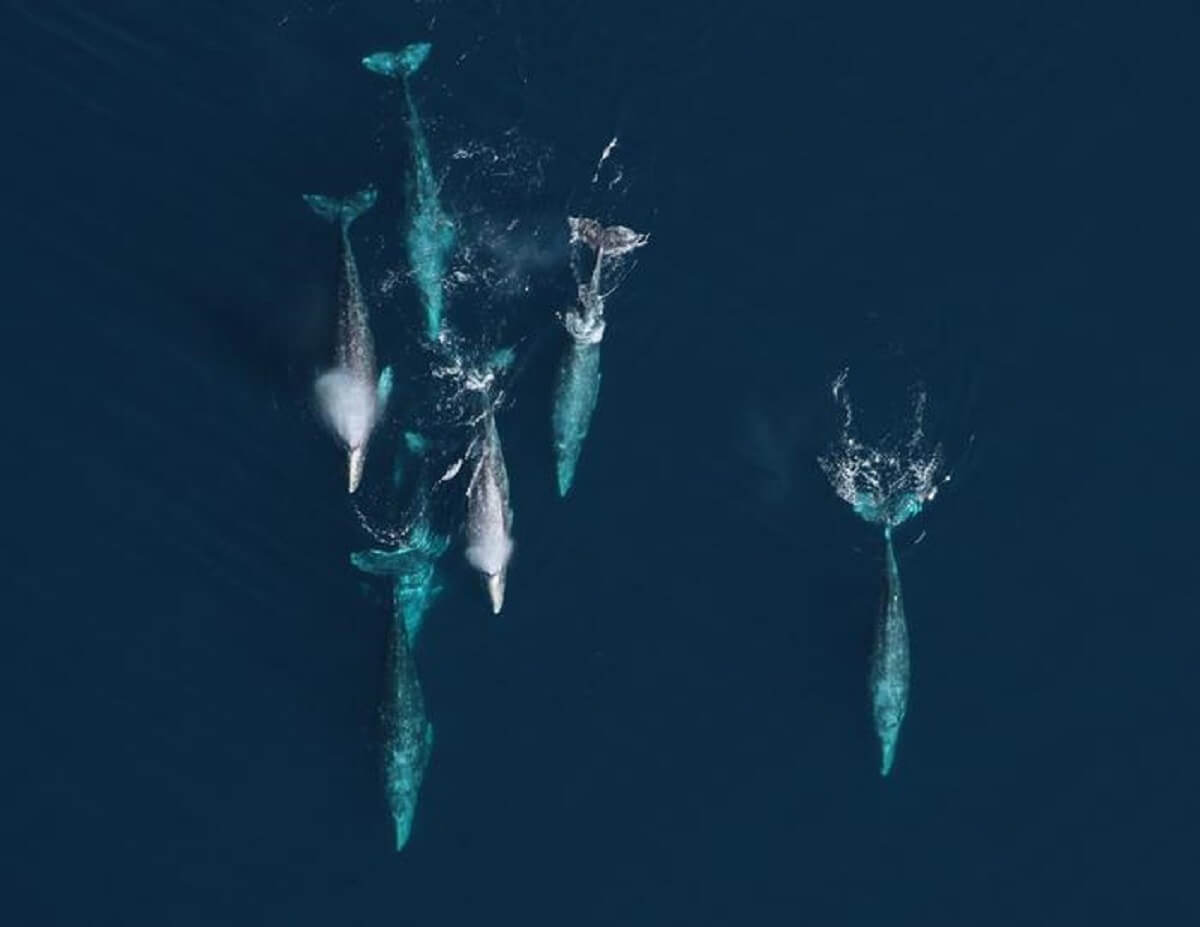
A gray whale breaching.
(Credit: NOAA Fisheries (Photo taken under permit))
OCTOBER 29, 2023
by StudyFinds
CORVALLIS, Ore. — Gray whales undergo substantial “boom-and-bust” population cycles in response to shifting Arctic conditions, new research reveals. Since the 1980s, scientists have observed three significant die-offs in the eastern North Pacific gray whale population. Each die-off, including an ongoing one that started in 2019, has led to a reduction in the gray whale population by as much as 25 percent within just a few years.
“These are extreme population swings that we did not expect to see in a large, long-lived species like gray whales. When the availability of their prey in the Arctic is low, and the whales cannot reach their feeding areas because of sea ice, the gray whale population experiences rapid and major shocks,” says the study’s lead author Dr. Joshua Stewart, assistant professor with Oregon State University’s Marine Mammal Institute, in a media release. “Even highly mobile, long-lived species such as gray whales are sensitive to climate change impacts.”
The researchers note that the eastern North Pacific gray whales, having rebounded from the effects of commercial whaling, are likely nearing the carrying capacity of their Arctic feeding areas, making them more vulnerable to environmental changes due to resource competition.

CORVALLIS, Ore. — Gray whales undergo substantial “boom-and-bust” population cycles in response to shifting Arctic conditions, new research reveals. Since the 1980s, scientists have observed three significant die-offs in the eastern North Pacific gray whale population. Each die-off, including an ongoing one that started in 2019, has led to a reduction in the gray whale population by as much as 25 percent within just a few years.
“These are extreme population swings that we did not expect to see in a large, long-lived species like gray whales. When the availability of their prey in the Arctic is low, and the whales cannot reach their feeding areas because of sea ice, the gray whale population experiences rapid and major shocks,” says the study’s lead author Dr. Joshua Stewart, assistant professor with Oregon State University’s Marine Mammal Institute, in a media release. “Even highly mobile, long-lived species such as gray whales are sensitive to climate change impacts.”
The researchers note that the eastern North Pacific gray whales, having rebounded from the effects of commercial whaling, are likely nearing the carrying capacity of their Arctic feeding areas, making them more vulnerable to environmental changes due to resource competition.

Gray whales migrating south between their summer feeding grounds in the Arctic and wintering lagoons in Mexico. Permit number 14097.
(Credit: NOAA Fisheries/SWFSC/MMTD)
Interestingly, the harsh Arctic conditions causing two of the die-offs in the 1980s and 1990s weren’t permanent. The whale population swiftly bounced back when conditions became favorable.
“It turns out we didn’t really know what a healthy baleen whale population looks like when it isn’t heavily depleted by human impacts. Our assumption has generally been that these recovering populations would hit their environmental carrying capacities and remain more or less steady there,” says Dr. Stewart. “But what we’re seeing is much more of a bumpy ride in response to highly variable and rapidly changing ocean conditions.”
Currently, about 14,500 eastern North Pacific gray whales make an impressive 12,000-mile annual migration along the Pacific Coast, transitioning from the warm waters off Baja California, Mexico, during winter to the chilly, nutrient-rich waters of the Arctic for summer feeding. For decades, the National Oceanic and Atmospheric Administration Southwest Fisheries Science Center in California has monitored this species, making the eastern North Pacific gray whales among the most extensively researched large whale populations globally.
“When we began collecting data on gray whales in 1967, little did we realize the important role they would play in understanding the effects of climate change on an iconic sentinel species in the Pacific. This research would not have been possible without our reliable long-term record,” says Dr. Dave Weller from the Southwest Fisheries Science Center.

Interestingly, the harsh Arctic conditions causing two of the die-offs in the 1980s and 1990s weren’t permanent. The whale population swiftly bounced back when conditions became favorable.
“It turns out we didn’t really know what a healthy baleen whale population looks like when it isn’t heavily depleted by human impacts. Our assumption has generally been that these recovering populations would hit their environmental carrying capacities and remain more or less steady there,” says Dr. Stewart. “But what we’re seeing is much more of a bumpy ride in response to highly variable and rapidly changing ocean conditions.”
Currently, about 14,500 eastern North Pacific gray whales make an impressive 12,000-mile annual migration along the Pacific Coast, transitioning from the warm waters off Baja California, Mexico, during winter to the chilly, nutrient-rich waters of the Arctic for summer feeding. For decades, the National Oceanic and Atmospheric Administration Southwest Fisheries Science Center in California has monitored this species, making the eastern North Pacific gray whales among the most extensively researched large whale populations globally.
“When we began collecting data on gray whales in 1967, little did we realize the important role they would play in understanding the effects of climate change on an iconic sentinel species in the Pacific. This research would not have been possible without our reliable long-term record,” says Dr. Dave Weller from the Southwest Fisheries Science Center.

A Southwest Fisheries Science Center researcher scans for gray whales during a survey as part of the long-term population monitoring research.
(Credit: NOAA Fisheries)
The research team’s analysis, which linked long-term data on gray whales with Arctic environmental information, found connections between the “Unusual Mortality Events” in 1999 and 2019 and factors like sea ice levels and the crustacean food source for the whales. They also identified a similar event in the 1980s that wasn’t associated with a surge in strandings, likely due to less efficient reporting before the 1990s.
Though shorter ice-covered periods in the Arctic initially seem beneficial for the whales, this trend, accelerated by climate change, may not be sustainable. The whales’ primary food source, benthic amphipods, relies on the sea ice. Algae growing beneath the ice nourish the amphipods, but less ice means less sustenance for them. As a result, smaller crustaceans thrive in warmer waters, and faster currents diminish habitats for the preferred whale prey.
“With less ice, you get less algae, which is worse for the gray whale prey. All of these factors are converging to reduce the quality and availability of the food they rely on,” Dr. Stewart emphasizes.
The current die-off event, according to Dr. Stewart, is lingering much longer than its predecessors. He postulates that the sustained impact might be due to the long-term shift in prey quality induced by climate change.
“An Arctic Ocean that has warmed significantly may not be able to support 25,000 gray whales like it has in the recent past,” Dr. Stewart cautions.
However, given the gray whale’s ability to adapt over hundreds of thousands of years, the team remains optimistic about the animal’s long-term survival.
The study is published in the journal Science.
South West News Service writer Stephen Beech contributed to this report.
The research team’s analysis, which linked long-term data on gray whales with Arctic environmental information, found connections between the “Unusual Mortality Events” in 1999 and 2019 and factors like sea ice levels and the crustacean food source for the whales. They also identified a similar event in the 1980s that wasn’t associated with a surge in strandings, likely due to less efficient reporting before the 1990s.
Though shorter ice-covered periods in the Arctic initially seem beneficial for the whales, this trend, accelerated by climate change, may not be sustainable. The whales’ primary food source, benthic amphipods, relies on the sea ice. Algae growing beneath the ice nourish the amphipods, but less ice means less sustenance for them. As a result, smaller crustaceans thrive in warmer waters, and faster currents diminish habitats for the preferred whale prey.
“With less ice, you get less algae, which is worse for the gray whale prey. All of these factors are converging to reduce the quality and availability of the food they rely on,” Dr. Stewart emphasizes.
The current die-off event, according to Dr. Stewart, is lingering much longer than its predecessors. He postulates that the sustained impact might be due to the long-term shift in prey quality induced by climate change.
“An Arctic Ocean that has warmed significantly may not be able to support 25,000 gray whales like it has in the recent past,” Dr. Stewart cautions.
However, given the gray whale’s ability to adapt over hundreds of thousands of years, the team remains optimistic about the animal’s long-term survival.
The study is published in the journal Science.
South West News Service writer Stephen Beech contributed to this report.
No comments:
Post a Comment